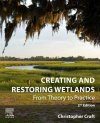About this book
Creating and Restoring Wetlands: From Theory to Practice, second edition, describes the challenges and opportunities relating to the restoration of freshwater and estuarine wetlands in natural, agricultural, and urban environments in the coming century. This second edition is structured by clearly defined chapters based on specific wetland types (e.g. Peatlands, Mangroves) and with a consistent and coherent organization for ease of discoverability. The book is divided into four main subjects: Foundations, Restoration of Freshwater Wetlands, Restoration of Estuarine Wetlands, and From Theory to Practice, each with multiple chapters.
Part 1, Foundations, contains chapters describing definitions of wetlands, ecological theory used to guide restoration, and considerations on where to implement restoration on the landscape. In Parts 2 and 3, restoration of specific freshwater (marshes, forests, peatlands) and estuarine (tidal marshes, mangroves) wetlands are described. Part 4, From Theory to Practice, contains chapters describing performance standards to gauge the success of projects and case studies describing small-scale and large-scale restoration projects of various freshwater and estuarine wetlands. Each chapter contains clearly labelled sections which assist the reader to quickly and easily key in on the subject matter that they are seeking.
The approach of Creating and Restoring Wetlands is unique in that, in each chapter, it links ecological theory important to ecosystem restoration with practical techniques to undertake and implement successful wetland restoration projects, including recommendations for performance standards to gauge success as well as realistic expectations and timescales for achieving success. Each chapter ends with a summary table describing the keys to ensure success for a given wetland ecosystem.
Contents
Acknowledgments
I. Introduction
1. Introduction
2. Definitions
3. Ecological theory and restoration
4. Consideration of the landscape
II. Restoration of Freshwater Wetland
5. Inland marshes
6. Forested wetlands
7. Peatlands
III. Restoration of Estuarine Wetlands
8. Tidal marshes
9. Mangroves
IV. From Theory to Practice
10. Measuring success: performance standards and trajectories of ecosystem development
11. Case studies
12. Restoration on a grand scale
V. Future of Wetland Restoration
13. Future of wetland restoration
Further reading
Index
Customer Reviews
Biography
Christopher Craft is the Janet Duey Professor of Rural Land Policy, O’Neill School of Public and Environmental Affairs, Indiana University, Bloomington and University of Georgia Marine Institute, where he teaches courses in Environmental Science, Applied Ecology, Wetlands Ecology and Restoration Ecology. His introduction to wetland science began in 1983 when, as a new PhD student, he began studying the ecosystem development of tidal marshes that had been created and restored along the North Carolina coast in the 1960s and 1970s. Since that time, Professor Craft has worked on restoration projects in freshwater wetlands of the Florida Everglades, Upper Klamath Lake (Oregon) and the agricultural Midwest, and in estuarine wetlands of the southeast (Sapelo Island, GA), New England and New York-New Jersey harbour. Professor Craft served as President of the Society of Wetland Scientists from 2008-2009. In 2012, he received the National Wetlands Award for Science Research, given annually by the Environmental Law Institute and six U.S. governmental agencies



































